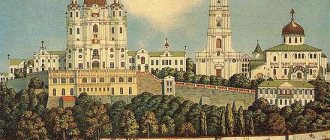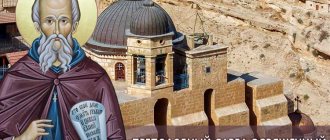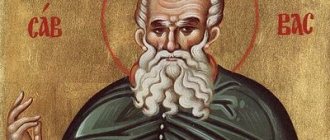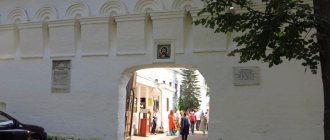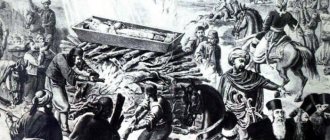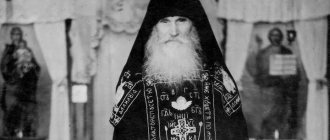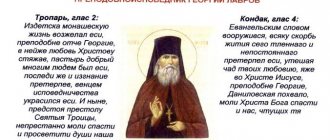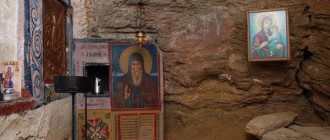"Save me, God!".
Thank you for visiting our website, before you start studying the information, please subscribe to our Orthodox community on Instagram, Lord, Save and Preserve † - https://www.instagram.com/spasi.gospodi/. The community has more than 60,000 subscribers. There are many of us like-minded people and we are growing quickly, we post prayers, sayings of saints, prayer requests, and timely post useful information about holidays and Orthodox events... Subscribe. Guardian Angel to you!
Saint Savva of Storozhevsky is one of the most revered monks in Rus'. His deeds, which were confirmed by faith, will forever remain in the souls of laymen and monks. After all, thanks to them, the Reverend was canonized as a Saint. Not so long ago, in 2007, the 600th anniversary of his tenure in this honorary, divine status was celebrated. Even during his lifetime, Savva was considered the very first and favorite student of St. Sergius of Radonezh.
Life of St. Savva of Storozhevsky
Presumably the monk was the son of a boyar family from the Principality of Smolensk. Unfortunately, these are just guesses, since there is no reliable information. The exact date of his birth is also unknown.
What is known is that from his youth he was a very pious boy, from childhood he fell in love with God and prayer, and lived in the Trinity Monastery under the supervision of St. Sergius. Later, the monk was elected confessor of the Trinity brethren. After the death of Radonezh, Savva became the abbot of the Trinity Church. This was in 1392.
In 1390, the monk blessed the construction of the Monastery of the Nativity of the Virgin Mary on Mount Storozhi, which is located in the village of Zvenigorod. This monastery was patronized by Prince Yuri Dmitrievich himself.
The saint more than once blessed Yuri on campaigns into the territory of the Horde (Volga Bulgaria, Dzhuke-Tau, Kazan, etc.). Most of these campaigns ended in glorious victory. Even later, the elder’s blessing helped save Muscovite Rus', which was threatened with complete destruction from the invasion of Tamerlane.
Savvino-Storozhevsky Monastery and Old Believers
It is noteworthy that in 1667, in honor of the arrival of foreign patriarchs to Moscow, who approved the church reforms of the 17th century, bellmaker Alexander Grigoriev cast the most famous Great Annunciation Bell in the Savvino-Storozhevsky Monastery, weighing 2125 pounds (about 34 tons). The bell had an unusually deep and beautiful sound, which had no equal in Russia: according to legend, its ringing reached all the way to Moscow. In 1941, they decided to remove Bolshoi Blagovest for melting down, but during the work it fell and broke. Currently, all that remains of him is a fragment of a tongue weighing 700 kg, which is on display. The Bolshoi Blagovest bell is depicted on the coat of arms of Zvenigorod.
One of the most famous Old Believer saints, Nikanor Solovetsky, labored in the Savvino-Storozhevsky Monastery. In 1654-1658. he was the abbot of the monastery. Subsequently, Nikanor became the archimandrite of the Solovetsky Monastery, where he led the Solovetsky uprising in defense of the old faith.
Monastery of Savva Storozhevsky in Zvenigorod
Construction of the monastery was completed by 1405. Several churches were erected on the territory of this holy place. The monk invited the famous artist Andrei Rublev to paint them, who, with the blessing of the priest, became the author of the Zvenigorod (Old Moscow) rite. The influence of the monk on the young artist was very great.
They say that he inspired the talented author to write the famous “Trinity” and “Savior of Zvenigorod”. The saint turned the monastery into a magnificent place of that time, where all believing peasants tried to get to.
The best article for you, go to: Icon of Equal-to-the-Apostles Princess Olga, meaning and what it helps with
The monk received everyone. He listened to people's sorrows and gave advice. He always acted as his parent, Sergius of Radonezh, taught him. Throughout his long life, the monk did not turn his back on anyone. He only humbly prayed and directed people along the path of God.
In 1407 the old man died. Before his death, he was very sick. Three days before his death, the monk gathered the Trinity brethren and told about all his righteous deeds. After his death, the descendants of Yuri and Vasily began a war for the throne. The Zvenigorod Monastery fell into decay. And the memory of the holy spring of Savva Storozhevsky was erased from memory by the hated relatives of Yuri, since he was his mentor.
Through the labors of St. Savva the Assumption Dubenskaya monastery was built
When Grand Duke Dimitri Donskoy defeated Mamai, in memory of this event he built a holy monastery in honor of the Dormition of the Blessed Virgin Mary on the Dubenka River. The Monk Savva was appointed to manage this monastery.
But some historians doubt that Savva could have been the abbot of the Dubensky monastery, because some sources indicate the name of another Savva, Stromynsky.
By order of Grand Duke Dmitry Donskoy, Sergius of Radonezh sent the Monk Savva to found a monastery on the Dubenka River. Photo: varvar.ru
Miracles that were performed by the Zvenigorod saint
Due to the war for the throne, information about the monk was erased from history. Savva was known only as a local saint. In the middle of the 26th century, the abbot was canonized. And a century later, the sacred relics of the saint were found in the Zvenigorod monastery.
Ruler Alexei Mikhailovich Romanov claimed that the image of Storozhevsky saved him from the clutches of an angry bear. From that time on, the king considered him his personal intercessor.
Another remarkable incident involving the Zvenigorod abbot happened in 1812. The image of Storozhevsky appeared to Eugene Beauharnais, the military leader of the French army under the command of Napoleon. The saint asked the commander not to cause trouble to the monastery walls of Zvenigorod and its inhabitants.
This way he will remain intact in the war that France will lose. When the abbot's prediction came true, the Zvenigorod Monastery regained its former popularity.
But the miraculous effects of Savva Storozhevsky’s prayer did not end there. Since 1998, the miraculous relics of the saint were transferred to the Zvenigorod Monastery. This was due to communist rule, which prohibited monastic and church activities.
The best article for you, go to: St. Jacob of Zheleznoborovsky
Part of the relics of the saint was saved from destruction by the pious Uspensky family
In the mid-twenties, an employee of the State Historical Museum, Mikhail Mikhailovich Uspensky, was invited to the Lubyanka. He was tasked with delivering a large silver dish covered with a cloth to the museum. On this dish lay the venerable head of St. Savva of Storozhevsky.
There were no orders regarding the relics, so Mikhail Mikhailovich reverently left them in his house and carefully kept them all his life. After the death of Mikhail Mikhailovich, the venerable head of the saint was handed over to the priest who gave him communion before his death.
Part of the relics, the honorable head of the monk, were kept in the Uspensky family for fifty years. Photo: journalpp.ru
Hermitage of Savva Storozhevsky
For prayerful communication with the Lord, the Reverend loved to leave the monastery. It was established that he went into a deep ravine, which was located a mile from the church. The monk dug a cave for himself on the side of a mountain, not far from a dense forest. In this cave he indulged in tearful prayers. Here he contemplated the highest abodes of heaven and earth. This place has been preserved for centuries in memory of the saint.
In 1870, a church was built above this monastery, which was named in honor of Savva Storozhevsky. Soon, an ensemble of the monastery monastery was erected near the church.
The legend says that not far from the monastery of the Zvenigorod monk there is a healing spring (spring). They say that he was caused by the prayer of Savva of Zvenigorod. This spring flows from the depths of the earth.
In order to get to this source you need to head along the walls of the Duck Tower to the Bell Tower. When you reach the stream, you need to cross the bridge and follow the signs along the dirt path. At the site of the source there is a wooden chapel and the font of Savva Storozhevsky.
They say that this healing font works incredible miracles. In order to heal your soul and body, you only need to plunge into it. But many argue that it only affects true believers. The source helps only those who are adamant in their faith and carry it in their hearts
Zvenigorod Monastery
It was erected on the site of a wooden church in 1398. There were joyful and sad moments in its history.
Crowned persons visited it more than once: Ivan the Terrible with his wife and children, Tsar Alexei Mikhailovich founded his residence here.
In 1919, the Bolsheviks plundered it and took away all its valuables. Restoration work began only in 1995, and continues to this day. Patriarch Alexy II returned the relics of the holy elder to the cathedral.
Video: Zvenigorod Monastery of Savva Storozhevsky
Saint Sava of Storozhevsky - what helps
People turn to the Reverend Monk from all over Russia and other CIS countries.
- People pray to him without even knowing what he helps with;
- They tell him about their problems, and they feel better;
- The saint helps everyone with his invisible hand;
- He guides lost souls to God;
- The saint will definitely answer a righteous, sincere prayer.
A particularly strong prayer to the Venerable on December 16th. On this saint's day they ask:
- about righteousness;
- about strengthening faith;
- about healing yourself or loved ones;
- about health;
- about integrity.
Reverence
In Orthodox culture, it is customary to purchase images of saints for the home. People believe that these shrines are able to protect them and give them peace of mind. The icon of Savva Storozhevsky is painted in the traditional oriental style.
Become a courier of the Yandex.Food service right now (up to 3,400 rubles per shift) leave a request →
An old man with a long beard, slightly curly gray hair, and an open forehead, looks directly at the person praying.
- A monk is depicted on a golden background - this is a symbol of the heavenly abodes where the souls of the righteous will dwell. The Orthodox Church believes that there are saints there who, with their prayers, can help those living on earth.
- The monastic mantle is thrown over the vestments, it symbolizes the angelic soul of those who renounce the sinful world.
- With his right hand, the mentor blesses the believers, and in his left hand he holds a scroll (a symbol of wisdom and enlightenment by the Holy Spirit).
Before the image, you can not only say a prayer to the saint, but also sing an akathist to Savva Storozhevsky. This will help to overcome passions, to focus on what is really important - the life of the spirit, its education in Christian virtues.
To venerate the holy relics, believers try to make a pilgrimage to the Church of Savva Storozhevsky, which is located in Zvenigorod. There you can visit the monastery, which is located a little away from the monastery, among the forest. It was above the ravine where prayer feats were performed that the temple was erected. This was done to preserve the memory of the ascetic of the Orthodox faith. Funds for construction were donated by one worthy merchant.
Here the tradition of a procession of the cross was begun, which takes place on the day of church memory of the saint. Many famous people came here to pray. Today the monks try to lead the same strict life, the example of which was set by the Monk Savva. It is believed that through the prayers of the monk one can be healed from illnesses of the body, find peace of mind, and find the right path in life. Through the prayers of St. Sava, have mercy on us, Lord!
Icon of Savva Storozhevsky
The icon of the Zvenigorod abbot is made in a fairly simple style. Its basis is based on the exploits of the monk and his service to Christ and the Mother of God. Even on the icon, Savva Storozhevsky carries the word of God to please the Lord Jesus Christ.
In this icon he is depicted in monastic robes. Over the robe is a black robe. This mantle is unfolded and somewhat resembles angel wings. The color of the robe is black. It symbolizes the perfection of renunciation of the vain world, peace and renunciation of passions.
The best article for you, go to: Rules for storing icons painted on a wooden base.
The face of the Saint is turned towards the praying person. In this way, a believer is better attuned to spiritual, internal dialogue, both with the saint and with the Lord.
Text of the Orthodox prayer to Savva Storozhevsky:
O most honorable and sacred head! Citizen of heavenly Jerusalem, abode of the Most Holy Trinity, Reverend Father Savvo! Having great boldness towards the All-Merciful Master, pray for the flock of your fence and for all your children in spirit. Do not remain silent when you cry to the Lord for us and do not despise those who honor you with faith and love. By your intercession, ask the King of those who reign for the peace of the Church, under the sign of the militant cross, for the bishop's splendor, for the good monastics in their labors; protection of this holy monastery, this city and all cities and countries; serenity and peace to the world, deliverance from famine and destruction; comfort and reinforcement for the old and weak, good growth in faith for the young and infants, solid training in the Gospel teaching, and abiding in purity and chastity; mercy and intercession to widows and orphans, joy and return to the captives, healing to those who are sick, peace to the faint-hearted, correction to those who have gone astray, those who sin with a spirit of contrition, those in need, and to all who require grace-filled help, timely help. Do not disgrace us, who come to you with faith, make haste, like a loving father to your children, for us to bear the yoke of Christ in complacency and patience, and guide us all in peace and repentance, to end our lives shamelessly and settle down with hope in the heavenly abode. Where you, through your labors and struggles, are now living with the Angels and Saints, in vain and glorifying God, glorified in the Trinity, the Father and the Son and the Holy Spirit. Amen.
The Lord is always with you!
Watch a video about the life of St. Savva of Storozhevsky:
Venerable Savva of Storozhevsky, Zvenigorod, abbot
Brief life of St. Savva of Storozhevsky, Zvenigorod
The Monk Savva of Storozhevsky, the Zvenigorod wonderworker, came very young to the monastery of St. Sergius of Radonezh († 1392, commemorated July 5 and September 25) and received monastic vows from him.
He was one of the first disciples and associates of St. Sergius. Under the guidance of this mentor, the Monk Savva learned obedience, humility, preservation of thoughts, abstinence and chastity. The monk loved silence, so he avoided conversations with people. He was never idle; often cried about the poverty of his soul. The saint ate only plant foods, wore rough clothes, and slept on the floor. The ascetic life of the Monk Sava won him universal love; he was made a presbyter and appointed by the Monk Sergius as the confessor of the brethren. The instructions of the Monk Sava were so edifying that not only monks, but also lay people opened their souls to him. With the blessing of St. Sergius, the monk Savva became abbot of the monastery of the Dormition of the Mother of God. It was arranged on the Dubenka River by the Grand Duke of Moscow, Righteous Dimitri Donskoy, in gratitude for the victory over Mamai. In 1392, when the successor of St. Sergius, Abbot Nikon, left the management of the monastery and secluded himself in his cell, the brethren of the Trinity Monastery begged St. Savva to return to their monastery and accept the abbot’s rod. For six years, the Monk Savva, resorting to the prayerful help of the Monk Sergius, tended the flock entrusted to him. Following the example of St. Sergius, Saint Sava, during his abbess, brought out a source of water through prayer behind the northern wall of the monastery.
Prince Yuri Dimitrievich of Zvenigorod, godson of St. Sergius, chose St. Savva as his confessor. At his request, the monk founded a new monastery near Zvenigorod. But, striving for solitude, the Monk Savva went to a deserted place - Mount Storozhevskaya. There he built a wooden church in honor of the Nativity of the Blessed Virgin Mary and a small cell for himself. Rumors of monastic exploits attracted many who sought solitude and a silent life to him. In 1399, the monk founded a monastery on Storozhevskaya Mountain and, with fatherly love, received all those seeking salvation, taught them monastic obedience and humility. The Monk Savva, despite his advanced years, worked hard to establish the monastery. Setting an example for the monks, he performed all the necessary work, warning everyone against idleness. The monk dug himself a cave about a mile from the monastery, in which he prayed for a long time with tears and devoted himself to the thought of God.
For his high virtuous life, the Lord was pleased to glorify the monk with the gift of clairvoyance. Before Prince Yuri Dimitrievich of Zvenigorod went to war, the holy elder, having prayed, blessed him and predicted his victory and safe return.
The saint died at a ripe old age on December 3, 1406. In a charter of 1539, the Monk Savva is called a miracle worker. In the middle of the 16th century. a description of the miracles was compiled. From the relics of the monk the sick were healed and demons were cast out from the possessed. Several times the Monk Savva of Storozhevsky appeared to the inhabitants of the monastery, who prayerfully turned to him for help.
One day the Monk Savva appeared in a dream to the abbot of the Storozhevsk monastery, Dionysius, who was an icon painter. After this vision, Abbot Dionysius painted the first icon of Saint Sava.
The celebration of St. Savva was established in 1547 at the Moscow Council and takes place on December 3. His incorrupt relics were found on January 19, 1652.
Complete life of St. Savva of Storozhevsky, Zvenigorod
St. Savva Zvenigorodsky was one of the disciples of St. Sergius, the Wonderworker of Radonezh. From his youth, having loved a pure and chaste life and rejecting the vain delights of the world, Savva came to the desert to St. Sergius and received monastic vows from him. Guided by his God-bearing mentor, he remained in perfect obedience to him, learning the rules of monastic life at the Trinity Monastery. Your life, St. Savva spent his time in strict abstinence and constant vigil, taking care to maintain mental and physical purity, which is the adornment of monastic life. The monk came to the church first for the Divine service and after everyone else he left it. With the fear of God, he stood in the church in prayer, in emotion he could not restrain himself from strong crying and sobbing, so that he surprised all the monks of the monastery. He constantly practiced church singing and reading, and in his free time from prayer and church services he was engaged in some kind of handicraft, fearing idleness - the mother of vices. The ascetic loved silence and avoided conversations with others. Therefore, he seemed to everyone to be a simpleton who knew nothing, but in fact he surpassed in wisdom many who consider themselves intelligent. He was not looking for ostentatious human wisdom, but for higher, spiritual wisdom, in which he succeeded. St. Sergius saw the successes of the saint better than others. Savva in spiritual life and appointed him confessor to all the brethren of the monastery.
In those days, the noble Prince of Moscow, Dimitri Ioannovich, defeated the infidel Tatar Khan Mamai and his hordes. Returning with joy to Moscow, the Grand Duke immediately came to the Monk Sergius at the monastery to pray and receive a blessing from him. At the same time, the prince turned to the holy elder with the following words: “Holy of God! When I wanted to speak out against the infidel Mohammedans, I promised to build a monastery in the name of the Most Holy Theotokos and set up a hostel in it. And now, honest father, with the help of Almighty God and the Most Pure Mother of God and your prayers, our desire has been fulfilled, our adversaries have been defeated. Therefore, I pray to your reverence: try in every possible way, for the Lord’s sake, so that our vow is soon fulfilled.”
The prince went to Moscow, and St. Sergius began to fulfill his request with zeal. He walked around many deserted places, looking for where it would be more convenient to establish a monastery. Arriving at a river called Dubenka, he found a place there that he liked very much. There St. Sergius created a church, and with it a monastery in the name of the Most Holy Theotokos, Her venerable Dormition. Soon some of the brethren came here. The monk gladly accepted them and then established a hostel here. The rector of this monastery is St. Sergius chose Blessed Savva from among his students, considering him quite capable of independent leadership of the brethren. Having prayed for him, the great ascetic blessed him and said: “May God help you, child, give you zeal and strength and may he guide you in all that is good and useful.”
Having accepted the blessing from the holy elder, St. Savva began to manage the Dubno monastery. He lived a pure life here, equal to the angels; he depressed himself with fasting and vigil, ate only desert plants, refusing all nourishing and tasty food; I never wore soft clothes. He often shed heartfelt tears, lamenting his sins, and indulged in the most severe monastic deeds.
Meanwhile, the brethren of the monastery began to multiply. The Monk Savva lovingly instructed them and served each one with humility and meekness. Thus the monk lived in the Dubno Monastery for more than 10 years.
On September 25, 1392, the Monk Sergius reposed in the Lord. Preparing for his departure from earthly life, six months before his death he entrusted the management of the Great Lavra to his closest disciple, St. Nikon. But Nikon, after the death of St. Sergius at first reigned over the Lavra for a short time; Wanting to remain in complete silence, he soon secluded himself in a special cell. The Trinity brethren, after much prayer, elevated St. to the abbess. Savva Dubensky. Having assumed the abbess at the Trinity-Sergius Lavra, St. Savva successfully managed the herd entrusted to him, assisted by the prayers of his great spiritual father and founder of the Lavra - St. Sergius. An ancient legend dates back to the time of the leadership of St. Savva in the Lavra miraculously brought forth through his prayers a water source outside the walls of the monastery, to the north, while the monastery needed water. After six years, Rev. Savva, seeking silence, left the management of the monastery, after which the brethren of the Sergius Lavra again elevated St. Nikon. St. Savva remained to asceticize in the Trinity Lavra.
Soon after this, the blessed Prince Georgy Dimitrievich arrived at the Trinity Monastery. Prince George was connected by spiritual ties with the Trinity Monastery. St. Sergius was his godfather, St. Savva - spiritual father. Now he turned to his spiritual father with a request to visit his house and give a blessing to everyone at home. Asked by the prince, St. Savva went to him, thinking to soon return to the Sergius monastery. But the Christ-loving prince began to persistently ask the venerable elder to never leave him, but to build a monastery on his estate near Zvenigorod and abbot there. Seeing the good will of the prince, St. Savva did not refuse to fulfill his request. He wanted to look for a suitable place to build a monastery, but the prince of Zvenigorod had already chosen and chosen such a place on Mount Storozhevskaya, one and a half miles from Zvenigorod itself. This place seemed to the monk like a heavenly paradise, filled with fragrant flowers. Prayerfully falling to the venerable icon of the Most Holy Theotokos, which the ascetic carried with him, he cried out to the Intercessor: “Mistress of the world, Most Holy Theotokos! I place the hope of my salvation in You. Do not reject me, Your wretched servant, for You know the weakness of my soul. And now, Lady, look upon this place and keep it safe from enemies. Be my mentor and nurturer until the very end of my life, for I have no other hope but You.”
Having thus prayed and placed all his hope in the Mother of God, St. Savva settled in that place. In a short time, he built a small wooden church here in the name of the Most Holy Theotokos, Her honest and glorious Nativity. Not far from her he built himself a small cell. From this time on, the monk tormented his flesh even more with fasting labors and deprivations, laboring in silence. Soon rumors of his holy life brought many to him, seeking a silent life, and the monk received everyone with love and was for them an example of humility and monastic labors. When enough of the brethren had gathered, St. Savva, following the model of the Trinity-Sergius Monastery that spiritually educated him, arranged a hostel for them. In his relations with the brethren, he tried to imitate his great teacher, St. Sergius, whose covenants he kept in his heart and observed in his ascetic activity; his orders and orders to the Venerable. Savva backed it up with his own example. Tradition has preserved the story about him that he himself, on his shoulders, overworked by exploits and age, carried water up the steep mountain to the monastery, and tried to do everything he needed for himself in order to teach the brethren not to be lazy and not to waste their days in idleness. All this pleased the blessed Prince George; he had to St. Savva, his spiritual father, had great faith and greatly revered him, patronized the newly created monastery and generously did good to it. By the grace of God and the prayers of St. Savva, the Storozhevsky monastery spread: the brotherhood increased with newcomers from neighboring cities and villages, seeking spiritual benefit and guidance in virtues. Like a loving father, St. Savva received everyone with love and in a fatherly manner constantly admonished them with soul-helping teachings. They, overcome by Divine love, kept the commandments of their mentor and bore the spiritual fruits of virtue.
In 1399, Prince George, by order of his brother, Grand Duke of Moscow Vasily Dimitrievich, had to go to war against the Volga Bulgarians. Just before the campaign, the pious prince came to the Storozhevsky monastery to ask his spiritual father for a blessing for the war. He asked St. Savva pray to the All-Merciful God, may he give him strength against his opposing enemies. The saint prayed and, taking up an honorable cross, overshadowed the prince with it and at the same time prophetically said: “Go, blessed prince, and the Lord will be with you, helping you. You will overcome your enemies and by the grace of God you will return healthy to your fatherland.”
Having received the blessing from the holy elder, Prince Georgiy Dimitrievich gathered his troops and went against the Bulgarians, conquered many cities and regions and returned to his patrimony with great glory and victory, as the venerable elder prophesied.
Upon his return with victory, Prince Georgy Dimitrievich hurried to the Monk Savva to thank him for his successful prayer and to pray in the monastery. After the thanksgiving service, the prince said to the ascetic: “I have found in you a great prayer book and a strong helper in battles, for I clearly see that only with your prayers I defeated my enemies.” The monk humbly answered the prince: “The good and merciful God, seeing your pious reign and the humility of your heart and the love that you show to the poor, granted you such a victory over the infidels, for nothing can bring you closer to God than through mercy towards the poor. And if you remain merciful to them to the end, then you will acquire many good things in this life and you will be an heir to eternal blessings.”
The prince made a generous donation to the monastery and established a meal for the brethren. After that, Prince George began to have even greater faith in St. Savva.
Following this, the grateful and pious prince hastened to prove his gratitude even more clearly, diligently delivering various benefits, gifts and contributions to the monastery of St. Savva. Cells for the brethren were again built and the monastery was surrounded by a wooden fence. But the best monument to the works of St. Savva and the charity of Prince Georgiy Dimitrievich, there remains a magnificent, majestic, extensive stone church in the name of the Nativity of the Virgin Mary, which still exists today, built on the site of the former poor, inconvenient and too small wooden church. Starting to build it, the pious prince gave St. Savva has a lot of gold, villages and estates. The pious prince also made other rich offerings to the monastery of his spiritual father, whose holy, ascetic life he revered.
Meanwhile, the humble elder excelled in virtues and spiritual gifts. While he was vigilant over others, he was even more, incessantly and unremittingly vigilant, vigilant over himself. His monastery was decorated, and the name of St. Savva was glorified everywhere around, as was the name of the Storozhevsky monastery. Monks flocked to him from all sides, seeking guidance in spiritual life and monastic deeds. Lay people came to him asking for instruction and guidance. Fearing and fleeing earthly glory, St. Savva went to his labors a mile from the monastery and there, in a deep ravine, under the shadow of a dense forest, he dug himself a cramped cave, where in complete solitude and silence, in repentance, he prayed to the Lord with tears. The monk alternated prayer and contemplation of God with handicraft and, despite his advanced years, he did not cease to work for the monastery: with his own hands he dug a well under the mountain, which to this day supplies excellent water for the monastery.
Thus, improving in spiritual life from day to day, St. Savva finally reached a ripe old age, never changing his statutory rule and having once rejected the world, he no longer cared about the worldly and vain; He never dressed in soft clothes and did not seek bodily rest, preferring a narrow and regrettable path to a long one. He loved poverty more than wealth, dishonor more than earthly glory, and endurance of sorrows more than vain joy. Finally, the monk fell into a dying illness. Feeling the approach of his death, the elder called the brethren to his deathbed, taught them enough from the Divine Scriptures, urged them to maintain spiritual and physical purity, have brotherly love, adorn themselves with humility and strive in fasting and prayer, and at the same time appointed one of his own as his successor, abbot of the monastery. students named Savva. After this, having taught everyone peace and kisses, the saint died on December 3, 1407.
The brethren of the Storozhevsky Monastery shed many tears, having lost their “nurse and teacher.” The news of the blessed death of St. Savva's church quickly spread throughout the surrounding area and attracted to the monastery many reverent admirers of him from monastics and laymen. Princes, boyars and residents of Zvenigorod gathered for the funeral. The grief was universal; everyone went to the burial, as if to the burial of their father. Many brought their sick people to the saint’s tomb. Body of St. Savva was buried in the Church of the Nativity of the Blessed Virgin Mary, built under him, on the right side.
Many years after the death of St. Savva, the abbot of the Zvenigorod monastery, named Dionysius, having finished his usual prayer rule, lay down to rest. And in a subtle dream he sees a handsome, gray-haired old monk who said: “Dionysius! Get up quickly and paint my face on the icon.” “Who are you, sir,” asked Dionysius in bewilderment, “and what is your name?” “I am Savva, the head of this monastery,” answered the magnificent old man.
Then the abbot woke up from sleep and, struck by the vision, called one of the disciples of St. Savva, Elder Avvakum, who saw the monk alive in his youth, and asked him about blessed Savva, what he looked like. Avvakum described the appearance of the monk and his age. From here Dionysius became convinced that the saint himself appeared to him. Savva ordered to depict himself on the icon. And since Dionysius himself was a skilled icon painter and a pious man, he diligently painted the icon of St. Savva. From then on, miracles began to happen at the saint’s tomb.
The brothers of the Savvina monastery grumbled against their abbot Dionysius and recklessly brought false complaints against him to Grand Duke John Vasilyevich (1462–1505). He believed the denunciation and ordered the abbot to immediately appear before him. The abbot fell into deep sorrow. And in a dream he sees blessed Savva, who, encouraging him, said: “Why are you grieving, my brother? Go to the prince and speak boldly, fearing nothing, the Lord will be your helper.”
Having risen from sleep, Dionysius prayed to God all night with tears. That same night, some of those grumbling saw in a dream a splendid old man who said to them: “Have you left the world for this reason, so that with grumbling you can accomplish the feat of monasticism? You grumble, but the abbot prays for you with tears and stays awake. What will prevail: your murmur or his prayer? Know that humility does not rest in the hearts of those who grumble, and God will not justify them.”
The brothers, waking up, retold their dream to the others. When they came to the Grand Duke, they could not say anything against the abbot, whom they had previously slandered, and remained in great shame, and Dionysius returned with honor to his monastery through the prayers of St. Savva.
One of the monks of the Storozhevsky Monastery suffered for a long time with his eyes, so that he could not see anything at all. One day he came to the tomb of St. Savva, prayed with tears and wiped his eyes with the veil that lay on the saint’s tomb. Another monk, looking at this, began to mock the patient and said with impudent mockery: “You will not receive healing, but you will only dust your eyes even more with sand.”
And so, the one who touched the saint’s tomb with faith received a quick healing, and the one who mocked him was suddenly struck by blindness, and heard a voice saying to him: “You have found what you were looking for. Let others learn through you not to laugh and not to blaspheme the miracles that happen from the saint of God.”
Then the blind man, having come to his senses, fell with fear and tears of repentance at the tomb of St. Savva, begging for forgiveness. The monk, generous in mercy, granted healing to the sinner.
One layman, a reverent admirer of St. Savva, who deeply believed in his prayerful help and intercession before God, after fervent prayers up to three times, was healed at the saint’s tomb from a serious illness. But as soon as he returned home, each time his illness returned to him to a greater extent. The pious layman understood in this the destinies of God for himself, realized that the monk was calling him to his monastery, and therefore, after his third healing, he no longer returned home, but remained in the monastery of the monk and accepted monasticism. He spent the remaining years of his life in repentance, humbly serving his brethren. His illness never returned to him.
At night, thieves crept into the monastery of the saint with the intention of robbing the Church of the Nativity of the Blessed Virgin Mary; but when they approached the window located above the saint’s tomb, they saw a high mountain that they could not climb. Then fear fell on the tatas, and they left with nothing. Subsequently, they confessed their sin and spent the rest of their lives in repentance.
One day, the boyar's son John Rtishchev arrived at the monastery of Savvin. He brought his sick son, George, to his sick bed, who could not even utter a word. They served a prayer service for him, after which they poured a little monastery kvass into his mouth. And a miracle happened: the sick man immediately spoke, was healed of his illness and ate the monastery bread. Seeing God’s mercy and the speedy healing of his son, John Rtishchev, with tears of joy, thanked the saint of God and called out to him as if he were alive: “Here I am, holy of God, in my house I have male and female servants who are obsessed with various ailments; I believe with all my soul, Reverend Father, that if you want, you can heal them too.”
Returning home with his recovered son, Rtishchev asked the abbot for consecrated monastery kvass. Upon arrival at his house, he ordered his maid Irina, deaf and blind, to be brought to him, he ordered kvass taken from the Savvina monastery to be poured into her ears, and to anoint her eyes with it. And with the prayers of St. Savva immediately cleared her hearing and saw her eyes, so that everyone marveled at the greatness of God and glorified God and His saint. Then Rtishchev called his servant Artemy, who had been deaf for seven years, and poured kvass into his ears, as if as a blessing from the saint. Savva, and he was healed. Finally they brought the blind girl Cilicia, poured that kvass on her eyes and she received her sight. After some time, Rtishchev himself was healed of his illness with the same blessed kvass. But, of course, it was not kvass that produced all these miracles, but the blessing and prayers of St. Savva and the zealous faith of the boyar’s son Ivan Rtishchev.
Abbot Misail of the Savvinsky Monastery fell into a serious illness, so that he lost hope of recovery and was near death. At this time, the monastery sexton Gury, going to announce the gospel for Matins, met a splendid old man near the church doors, who asked him: “How is your abbot doing?” Gury told him about his abbot’s illness. The elder, having listened, said to him: “Go and tell the abbot, so he will call the Most Holy Theotokos and the head of this place, Elder Savva, for help - and he will receive health. Open the church doors for me to enter the church.” Gury doubted and did not want to open the doors, because he did not know the elder who had appeared, and asked him: “Who are you, sir, and what is your name?” But the elder who appeared did not answer anything, he only went to the doors of the temple - they opened by themselves, and he entered the temple. Gury, in great fear, called another sexton and began to reproach him, saying: “Why didn’t you lock the church doors in the evening? So I saw a stranger who entered the church through the open gates.” But he assured Gury with an oath that in the evening he had tightly locked the church. Both monks became embarrassed, lit candles and went to the church, but the doors were closed and, as it turned out, tightly locked. At the end of Matins, Gury told the abbot and the brethren about everything he had seen and heard. Then everyone realized that the magnificent old man who appeared to Guria was none other than St. Savva. Hegumen Misail ordered to immediately carry himself to the tomb of the monk and soon after that he received healing.
Under Abbot Afanasy, the following miracle took place through the prayers of the saint. The memory of St. Savva. The cellarer Gerontius, with the blessing of the abbot, wanted to arrange a more delicious meal for this day to console the brethren. They brought a large clay vessel with oil; then a wooden beam suddenly fell from the ceiling directly onto the vessel and broke it. There was very little oil left in the monastery, but the abbot said to the cellarer: “In all this, brother, we must place our trust in the Lord God and in His saint, the great wonderworker Savva, for he can multiply even small things. For now, you ordered the food to be prepared, and whatever God gives, we will offer it to the brethren at the meal.”
Indeed, through the prayers of St. Savva not only had enough butter for the brethren’s festive meal, but there was also some left over.
Honoring St. Savva's presence at his tomb as a saint of God began soon after his repose, and he was canonized by the Church in the 15th or first half of the 16th century. The incorrupt relics of the saint of God were discovered almost two and a half centuries after his death, during the reign of the most pious Alexy Mikhailovich, in 1652. Finding the holy and incorruptible relics of St. Savva was caused by numerous miraculous healings and miracles that took place at the tomb and through his prayerful intercession. The closest reason for finding the relics of St. Savva, according to the ancient legend existing in the Storozhevsky Monastery, was the appearance of the saint of God to Tsar Alexy himself. During one of his visits to the monastery, Alexy Mikhailovich went hunting in the surrounding Zvenigorod forests. When his retinue scattered through the forest to find the bear’s lair and he was left alone, a bear suddenly ran out of the forest thicket and rushed at him. The king, seeing the impossibility of defending himself, doomed himself to certain death. Suddenly an old man appeared near him, and with his appearance the beast fled from the king. Asked about his name, the elder replied that his name was Savva and that he was a monk of the Storozhevsky monastery. At this time, some of his retinue gathered to the king, and the elder went to the monastery. Returning to the monastery, Alexy Mikhailovich asked the archimandrite about the monk Savva, thinking that he was some ascetic still unknown to him who had settled in the monastery. The archimandrite answered the king that there was not a single monk in the monastery with the name of Savva. Then the king, looking at the image of the saint, realized that it was himself, and ordered a prayer service to be served and the coffin to be examined for the preparation of the holy relics of the saint. Savva for the grand opening.
Many other miracles and appearances of the saint of God preceded the discovery of his relics.
February 1/January 19 – Finding of relics
The ceremonial opening of the relics of St. Savva was performed on January 19, 1652 in the presence of the sovereign Alexy Mikhailovich himself, his wife Queen Maria Ilyinichna, the All-Russian Patriarch Joasaph, the Novgorod Metropolitan Nikon, later the famous All-Russian Patriarch, and countless people not only from Zvenigorod and its environs and the entire Moscow district, but also from distant cities and the entire great Russian land. The relics of St. Savva was found incorrupt after a 245-year stay in damp earth and placed in an oak tomb on the right side of the cathedral, at the southern gate leading to the altar of the Church of the Nativity of the Mother of God of the monastery.
And after the discovery of the holy incorruptible relics of St. Savva, many miracles were performed at his grave. We will not list them here. Let us point out only one remarkable case of the afterlife appearance of a saint of God to the enemy of the Russian land. This happened in 1812, when our Fatherland was devastated by the huge hordes of the French Emperor Napoleon Bonaparte. While he captured Moscow, Prince Eugene Beauharnais, the Italian Viceroy, with a 20,000-strong detachment approached Zvenigorod from Moscow. He occupied rooms in the Storozhevsky monastery, and his soldiers scattered throughout the monastery and began looting, not even sparing temples and holy icons. But the monk himself, by his appearance, frightened and brought sense to the daring robbers. One evening, Prince Eugene, without undressing, lay down and fell asleep, and then, in reality or in a dream - he himself did not know it - he saw some handsome old man in a long black monastic robe enter the room and come up to him so close that he had the opportunity in the moonlight to examine his facial features and menacing gaze. The one who appeared said: “Do not order your army to plunder the monastery, especially to carry away anything from the church. If you fulfill my request, then God will have mercy on you and you will return to your fatherland safe and sound.”
Frightened by the vision, the prince gave the order in the morning for his detachment to return to Moscow, and he himself went to the cathedral church and at the tomb of St. Savva saw the image of the one who appeared to him at night, and, having learned whose image it was, he reverently bowed to the relics of the monk and wrote down what happened in his book. Then the prince ordered the cathedral temple to be locked, sealed it with his seal and assigned a guard of 30 people to the doors of the temple. It is necessary to add to this that, according to the prediction of St. Savva, while all the other main military leaders of Napoleon ended unsuccessfully, Prince Eugene remained unharmed and was not even wounded anywhere in the battles after that.
August 10/August 23 – Second discovery and transfer of relics
The October Revolution of 1917, which so terribly changed the entire life of the Russian state, also affected the honest relics of St. Savva Storozhevsky.
The relics of the saint were first opened and desecrated back in May 1918, long before the official decision of the Bolshevik authorities. On February 1, 1919, a decree of the People's Commissariat of Justice was published on the widespread organized opening of relics. On March 4 of the same year, the holy relics of St. Savva Storozhevsky. When the confessor of the monastery, Hieromonk Savva, an eyewitness to the events, was asked about what was happening: “What, Father Savva, was it like during the autopsy?”, he answered: “Horror... everything was like in the Garden of Gethsemane, both desecration and spitting...”.
Parishioners of the Savvino-Storozhevsky Monastery tried to protect the holy relics from desecration and wrote complaints to the People's Commissariat of Internal Affairs and Justice, pointing out the offensive actions of the local authorities at the shrine of St. Savva. The parishioners' defense of the Zvenigorod shrine led nowhere. April 5, 1919 the holy relics of St. Savva was taken from the monastery to Lubyanka.
This is where I remembered an ancient monastic legend: shortly before his death, St. Savva “at one time began to cry and said to his brethren: “The time will come when people on earth will forget God and laugh at Him, the power of the Antichrist will come to power. She will kick me out of the monastery, but I will not leave at all. I will move to another place where some people will not forget God, and I will pray for them before the end of the world.” This is the prophecy of St. Savva Storozhevsky was even published in Soviet newspapers of those years as proof of the counter-revolutionary nature of monasticism.
For a long time it was believed that the holy relics of the Zvenigorod Wonderworker were lost forever. And only in the early 90s. XX century it became known that the honest head of St. Savva was secretly kept by the spouses Mikhail Mikhailovich and Sofia Dmitrievna Uspensky for more than 50 years.
About how the relics of St. The Savvas ended up in the Uspensky family, the following is known. In the 20s, Mikhail Mikhailovich, an employee of the State Historical Museum and a member of the Commission for the Protection of Architectural Monuments of the Moscow Region, was summoned to the Lubyanka. The employee who called him showed Mikhail Mikhailovich a silver dish, covered with cloth on top, and said: “Take this dish and give it to the museum, and place what is on the dish - the remains of Savva Storozhevsky - wherever you see fit.” MM. Uspensky kept the relics at home, and three years before his death, worrying about the fate of the shrine, through Archpriest Vladimir Ganin, rector of the Assumption Church in the village. Zhilino, Lyubertsy district, Moscow region, addressed Fr. Evlogy (Smirnov), then the steward of the Trinity-Sergius Lavra, with the question: what to do with the relics? Father Eulogius advised him to transfer the relics to the Lavra. Later, when Fr. Eulogius was already the governor of the newly opened St. Danilov Monastery, he called the Uspenskys and asked about the fate of the relics of St. Savva. Mikhail Mikhailovich had died by that time, and his relatives reported that they handed over the relics to the priest, who gave his farewell to M.M. Uspensky before his death. “Please take them as our father promised you,” they added. On March 25, 1985, the shrine was transferred to the Moscow St. Daniel Monastery, the patriarchal and synodal residence, where it rested in the altar of the Church of the Seven Ecumenical Councils.
On August 22–25, 1998, the Savvino-Storozhevsky Monastery solemnly celebrated its 600th anniversary. In honor of this event, with the blessing of His Holiness Patriarch Alexy II of Moscow and All Rus', Holy Archimandrite of the Savvinsky Monastery, the honorable relics of St. Savva was solemnly transferred to the monastery he founded.
Preparations for the anniversary of the monastery and the transfer of holy relics united the efforts of many, many people. In record time, a huge amount of repair and restoration work was carried out, the first 10 bells were cast and raised to the belfry, and the relics of the saint were recreated according to old models. Savva, the “small monastery” was restored, the territory of the monastery and its immediate surroundings was landscaped.
The celebration of the anniversary began on the morning of August 22, 1998 in the Trinity Cathedral of the St. Daniel Monastery. His Holiness Patriarch of Moscow and All Rus' Alexy II with a council of archpastors served the Divine Liturgy and a prayer service, after which the ark with the relics of the saint was carried in a procession to the Holy Gates of the monastery, accompanied by the ringing of bells and prayerful singing, where His Holiness the Patriarch overshadowed the holy relics of all those present.
After this, the ark was carried into the bus, and a column of 15 buses and several dozen cars set off on their way to the Savvino-Storozhevsky Monastery.
In Zvenigorod, at the Church of the Holy Blessed Prince Alexander Nevsky, the column stopped, and the religious procession continued on foot. Residents perceived the return of their heavenly patron and intercessor as a miracle, as God's mercy shown to the Zvenigorod land.
Under the incessant ringing of bells, a procession of thousands of people approached the Holy Gate of the monastery, from which His Holiness the Patriarch emerged. He accepted the ark with the holy relics and brought it into the monastery. After the placement of the ark in the Nativity Cathedral in the renewed shrine, the festive all-night vigil began with the patriarchal service.
Thus, another patronal holiday appeared in the Storozhevskaya monastery - August 23, with the blessing of the monastery’s holy archimandrite, His Holiness Patriarch of Moscow and All Rus' Alexy II, which was included in the church calendar as the day of the Second Finding and Transfer of the Venerable Relics of St. Savva Storozhevsky.
Five centuries have passed since the holy saint of God, Savva, shone on earth. People changed, morals changed, the 20th century passed with its deniers of God and miracles, but the monastery of Savvina stands, preserved by the prayers of its founder, people still flock to venerate his holy relics, those who seek help with faith still receive it and glorify God and His Pleasant, St. Savva[1].
See also: “The Repose of St. Savva of Storozhevsky” as presented by St. Demetrius of Rostov.
Notes
[1] Source: Website of the Savvino-Storozhevsky Monastery.
